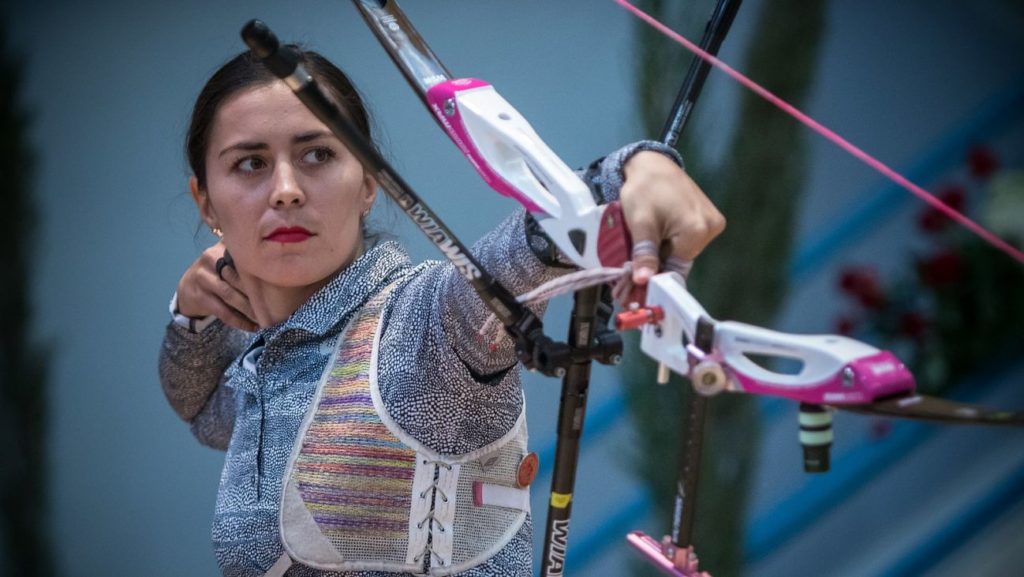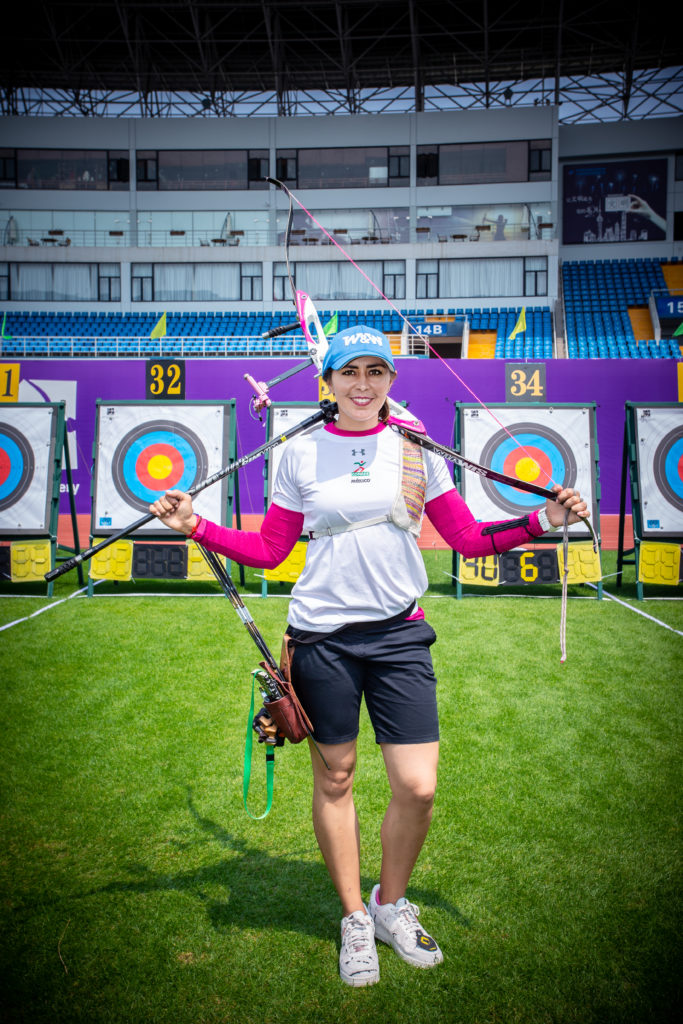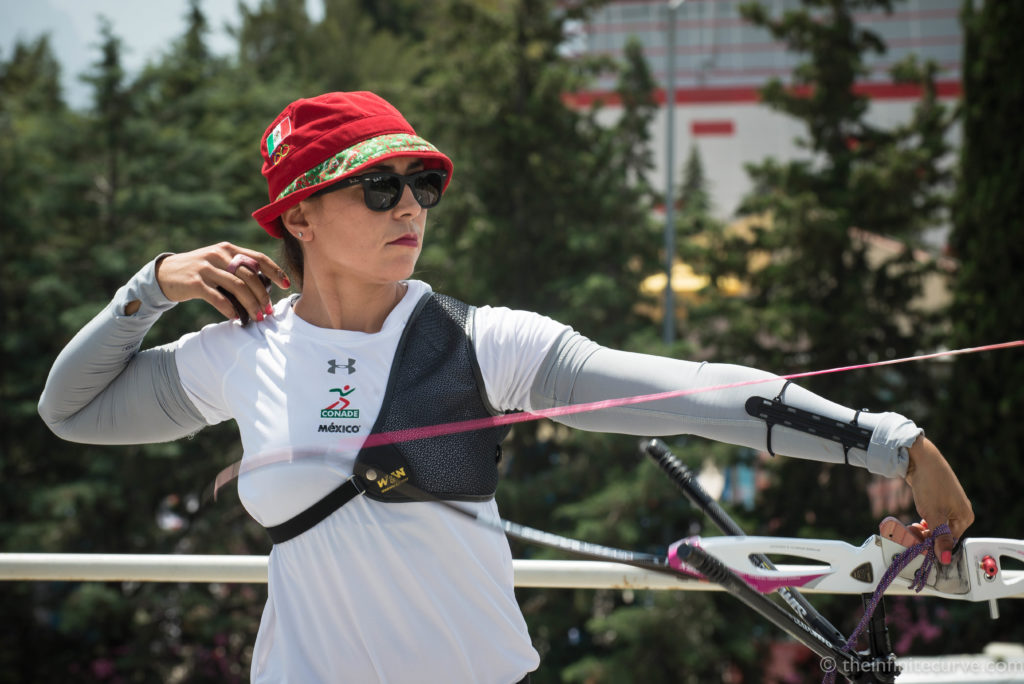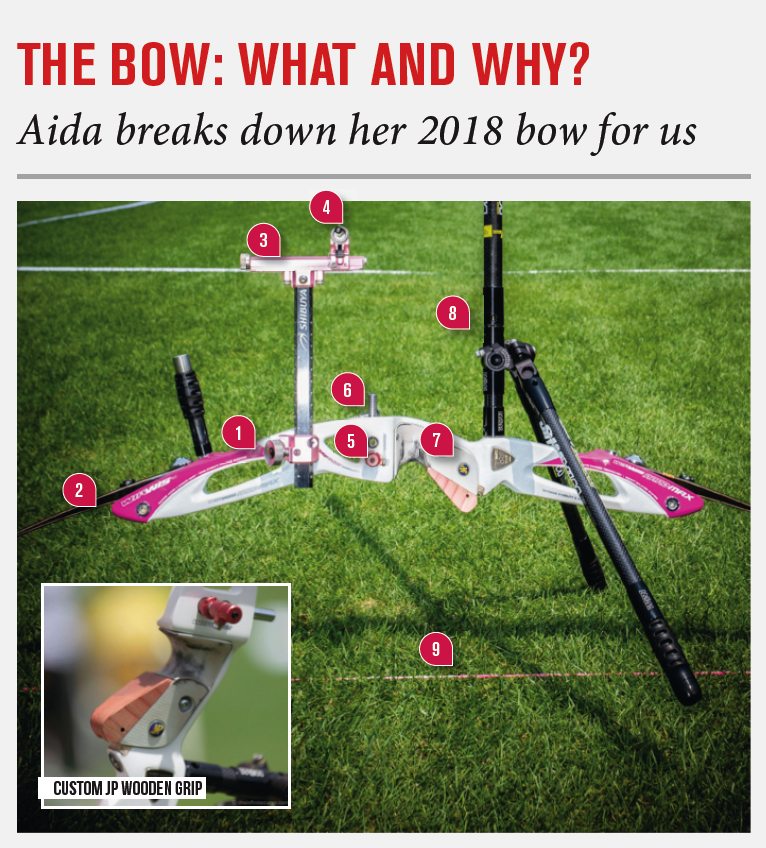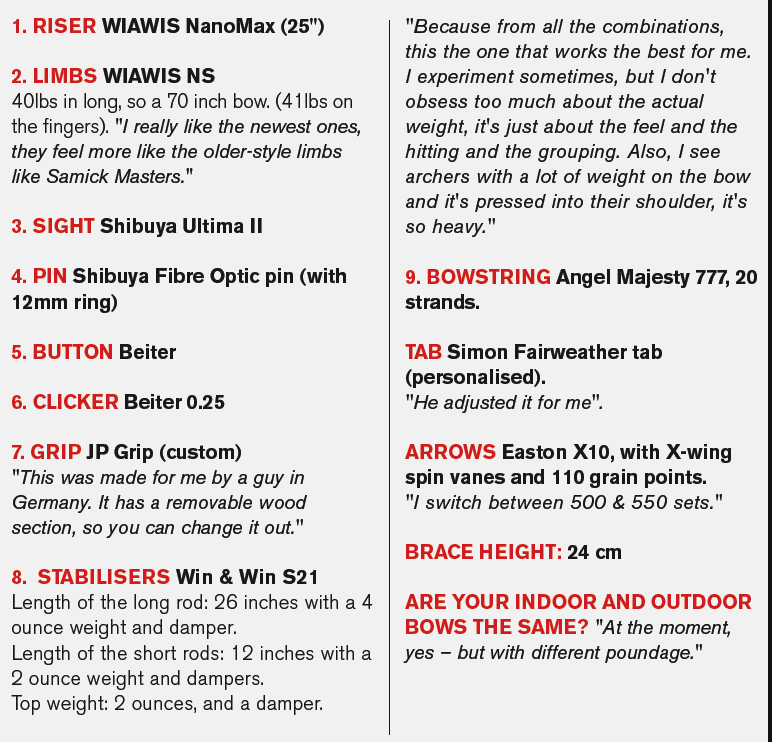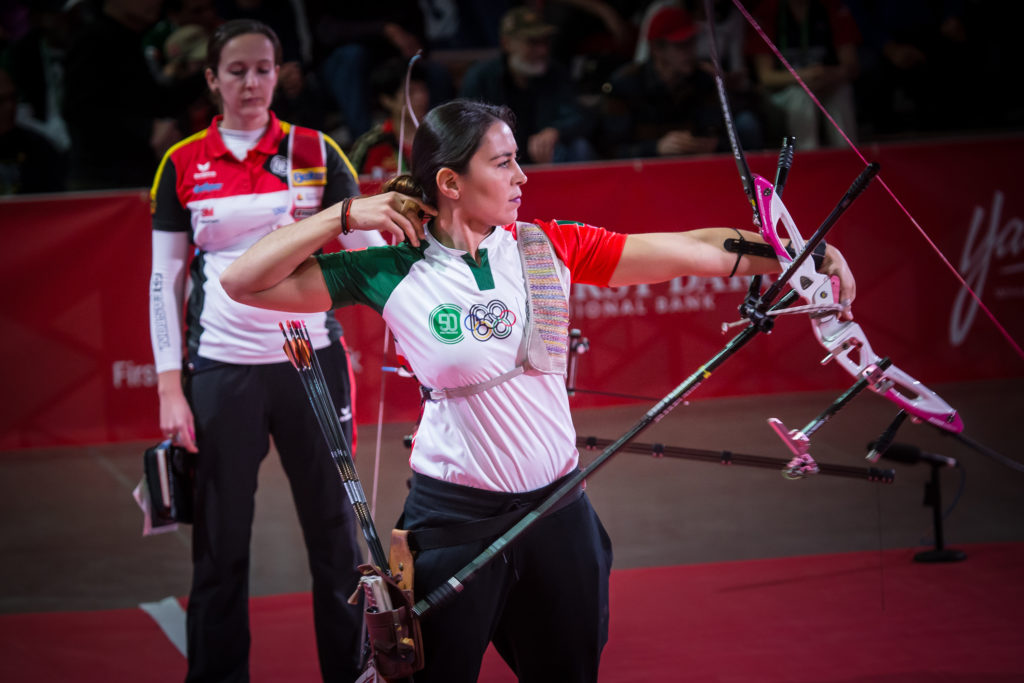Aida Roman became Mexico’s first silver medallist in archery at the Olympics during London 2012. We found out how she got there and how her life has changed since. By Andrea Vasquez.
(Entrevista en inglés primero. Español sigue.)
Twenty years ago, Aida Roman skipped a gymnastics class to accompany her father to an archery course. At the age of 10, watching a handful of Mexico City’s eight million inhabitants shoot wooden arrows with wooden bows at wrapped straw targets, she fell in love with the sport.
Thirteen years later, she climbed the Olympic podium.
“I remember I thought it was beautiful,” she says when I asked her how it all started.
“At first, I was angry with my dad for having to miss my class but when we arrived to the place, I embraced the opportunity to learn something new. I asked my dad if I could try it and I loved it. One month later, I was shooting my first competition.”
Coming from gymnastics, a sport in which the judge gives scores and coaches are critical about what an athlete has to improve, Aida quickly learned that archery was more a self-learning process.
It wasn’t until 2007, after a training camp in China, that she made the Mexican national team.
“I remember I had the lowest scores among the team in training, but when I went back home and had to shoot the selection tournament for the national team, I beat all the girls to make it.” And she hasn’t missed making the team ever since.
Growing up in a problematic neighbourhood in Mexico City, Aida, the middle child and only daughter in a family of five children, said her daily routine was: from home to school, from school to archery, and from archery back home.
It was a childhood with few friends and the permanent protection of her parents.
“Archery has given me many things but one I value a lot is freedom. Where I grew up the possibilities of ending up pregnant at very young age, addicted to drugs or even missing were pretty high. If it wasn’t for the sport, I might have not be where I am today,” says Aida.
“Archery opened my world and I cling to that. Thanks to it, I built my own money; I have my own house, a car, I have my friends, and my boyfriend; and I discovered that I can be good at something that feels unique because in my country, despite its history, archery is still a relatively new sport.”
It’s an incredible journey, and one that has also been won through sacrifice. Aida put her professional psychologist studies on stand-by to dedicate her life to archery.
“I used to worried a lot about it, but I think the best advice I was ever given was to not worry about a degree for the sake of having a paper that says I am a professional, but to value what I have achieved in my sporting career for myself, my country and what’s still to come,” she explains.
“My studies will always be there, but archery might not. So I thought better to give my best at one thing than splitting my time in two but not ending up good at either. I’m giving it time but so far, I think this has been the best decision I have ever made.”
The Olympic medal
In 2012, her face was all over the Mexican newspapers, television and radio stations, as people learned the name Aida Roman.
She became an Olympic silver medallist at the Games held in London that year, where Mexico also took individual bronze in the recurve women’s competition courtesy Aida’s teammate Mariana Avitia. It was a huge surprise, as Mexico was almost unknown as an archery nation.
“It changed my life completely,” says Aida. “And it has given me both the good and the bad ever since.”
“On the positive side, I have gained personal goods, fame, and national and international recognition. I have gained memories from people from all around the world that tell me how moved they felt when I won, what they were doing or with who they watched my match, and that’s something I just love.”
“I think it’s nice that when people know that you are an Olympic medallist and learn how much work and effort you put into to win it, they respect you. It’s the beautiful side of the fame.”
“But it also has a negative side. Your life is exposed to the media, and in Mexico, the media is opportunist.”
Two years after she won the Olympic silver, Aida had one of her best archery seasons to date. In 2014, she won the World Archery Indoor Championships in Nimes, France and the Archery World Cup Final in Lausanne, Switzerland.
She cemented her status as one of the best recurve women in the world but for Mexico she was still ‘the Olympic silver medallist’.
“I think no matter what I achieve, even if the champion titles might have been more difficult for me to win, I will always be the Olympic medallist. For some people, for the media, the rest will always come second.”
It was a fame she brought to the latest edition of the Games in Rio de Janeiro, Brazil in 2016, where she lost in the first round to Alexandra Mirca of Moldova in five sets, four points to six, and broke down in tears to a broadcast camera immediately afterwards.
“It was hard. I have never promised anything to anyone but the media will use whatever I say to their own benefit. They put the responsibility of more than the 120 million inhabitants that Mexico has on me because I previously won one medal, and it affected me,” she admits.
“Some of the titles were hurtful and some of the media was rude to me, so I blocked them. There are some reporters I don’t talk with or I don’t give interviews to because of that. But there are others that are good, that will care about me as a person and not just as the athlete, and that, I value.”
To protect herself from similar situations in the future, Aida hired a sports marketing agency to act as her shield and represent her public image. They manage her social media platforms, sponsorships and interviews.
It’s part of her role as a professional athlete in Mexico, where along with her national teammates she’s been working to raise the level and public awareness of the sport, while maintaining her own results.
“Archery has grown a lot in Mexico. We have worked hard to gain ground, to compete worldwide and win, and to try to be one of the best teams in the world. There’s still work to do, but at least we now have a base from where to set goals and continue from.”
The future
At the Mexico City 2017 Hyundai World Archery Championships, Aida, with Mariana Avitia and Alejandra Valencia, secured the recurve women’s team silver medal on home soil, losing to just Korea in the final.
Aida’s career now includes an individual world indoor title, plus a silver, and two world outdoor second place finishes – one in teams and one in mixed. Plus that Hyundai Archery World Cup crown from 2014.
Is is the quest for an individual world title that drives her?
“Yes and no. In an Olympic year, the world championships give you spots for the Games and what really matters is to gain them, because the possibilities to win a medal with the team are higher than individually. I think this is why outdoor has been a bit more difficult for me, because I’m thinking about the team, not about myself,” says Aida.
And it’s with the team that her future Olympic hopes rest.
“To win a medal with the team at the Olympics. We have been so close and so far, that’s still a dream. I hope one day we can make it happen.”
Aida will shoot all four stages of the Hyundai Archery World Cup in 2018, whether sent by her national federation or funded herself.
The 30-year-old is positive and optimistic about her personal and professional path yet to come. As we finish our interview, I ask Aida what makes her different from other archers and the answer summarises not just this Olympic silver medallist, this champion, but archery in general.
“If today wasn’t a good day, move on. Tomorrow will be different and you can try to turn the situation around. Fix it, whatever it is, because otherwise, you will be stuck forever,” she says.
“In archery you don’t depend on others, you only depend on yourself.”
How to shoot like Aida Roman!
Where did you learn your technique?
I’m still learning it. Every coach I have had has had their own technique, but my body has chosen from the best of each of them. Right now, for example, I’m working with Kisik Lee’s technique but not all of it because I have my own style. I’ve taken what works for me and leave what doesn’t, making the best of it for me.
How has it changed as you have improved?
My technique has changed in the way I now analyse my abilities and understand my body to execute it properly. I now know I have long extremities but a small trunk, big hands but small fingers, and that is what I didn’t pay attention to before. This is key while you are growing up and changing what you don’t feel comfortable with, because I think every step in your technique is important. If you miss something, then you start to make mistakes.
Tell us about a typical practice week for now, building up to the outdoor season.
I wake up, get ready and go to the practice field. I normally tend to practice with the stretch bands, train at five metres to help my flexibility and then move to 70 metres. Depending on what the goal is, I chose the number of arrows and hours of training. If I’m with the team, then we practice the team routine, we simulate matches and we compete between each other.
What’s the one thing archers should do to improve, apart from shooting practice?
I think professional archery is a lifestyle. From the moment you wake up until the moment you go to bed, you think about it. Yes, you have to practise, but you should also go to the gym to have control of your body and strengthen those muscles that are important for you to execute your technique properly.
Archers should not have doubt in their shot routine, because when you are stressed or blocked it is remembering your technique that will help you stay focused and calm.
Supervivencia en la cima
Aída Román se convirtió en la primera mexicana en ganar una medalla olímpica, de plata, en tiro con arco. Descubrimos cómo lo logró y cómo ha cambiado su vida desde entonces.
Por Andrea Vásquez
Hace 20 años, Aída faltó a una clase de gimnasia para acompañar a su padre a un curso de tiro con arco. Con tan solo 10 años de edad se enamoró del deporte a primera vista. Le bastó con observar a un puñado de mexicanos disparar flechas con un arco de madera en dianas de paja. Trece años después subió al pódium olímpico.
“Recuerdo que pensé que era hermoso”, dijo cuando le pregunté cómo empezó todo.
“Al principio estaba enfadada con mi papá porque no me gustaba faltar a mis clases de gimnasia, pero cuando llegamos al lugar del curso, asumí la actitud de aprender algo nuevo. Le pregunté a mi papá si podía tirar unas flechas y me enamoré. Al mes ya estaba en mi primera competencia”.
Proveniente de gimnasia, un deporte en el que los jueces evalúan y los entrenadores son fundamentales en el crecimiento de un atleta, Aída notó rápidamente que en el tiro con arco el proceso de formación era mucho más personal.
Fue solo en el 2007, luego de un campamento en China, que Aída llegó a ser parte del equipo nacional mexicano.
“En el campamento en China mis puntuaciones eran las más bajas de todas, pero cuando regresé a México y tiramos el selectivo, le gané a todas las chicas”. Desde entonces, nunca ha quedado por fuera del equipo nacional.
Aída creció en un barrio problemático de Ciudad de México. Es la tercera y única mujer de cinco hermanos, y su rutina de infancia era de la casa al colegio, del colegio a entrenar y de entrenar a la casa. Fue una niñez con muy pocos amigos y una sobreprotección permanente de sus padres.
“El tiro con arco me ha dado muchas cosas, pero una que valoro mucho es la libertad. Donde crecí, las posibilidades de quedar embarazada muy joven, volverse adicta a las drogas o que te robaran, eran muy altas. Si no fuera por el deporte, posiblemente no estaría donde estoy ahora,” dijo.
“El deporte me abrió el mundo y yo me aferré a ello. Gracias al tiro tengo mi propio dinero, mi casa, mi coche, tengo a mis amigos, a mi novio y descubrí que puedo ser muy buena en algo que se siente único, porque en mi país, a pesar de su milenaria historia, el tiro con arco sigue siendo una disciplina muy nueva”.
Para ella ha sido un viaje increíble, lleno de sacrificios. Uno de ellos, el dejar de lado sus estudios universitarios de Psicología para dedicarse de lleno al deporte y llegar a ser la atleta que es hoy.
“Antes me preocupaba mucho, pero después alguien me dio el mejor consejo que pude escuchar y fue el de no preocuparme por un título solo por tenerlo, sino por valorar todo aquello que ya he logrado y que aún puedo lograr en mi carrera deportiva”.
“Mis estudios siempre van a estar, pero es posible que el deporte no. Así que prefiero dar lo mejor de mí en el tiro con arco que dividir mi tiempo en dos cosas y no ser buena ni en lo uno ni en lo otro. Creo que ha sido la mejor decisión que he tomado”.
La medalla olímpica
En el 2012, su rostro llegó a todos los periódicos, canales de televisión y estaciones de radio en México. Rápidamente, todos se aprendieron su nombre.
Aída se convirtió en medallista de plata en los Juegos Olímpicos de Londres, en los que su compañera de equipo, Mariana Avitia, se llevó el bronce. En aquel entonces, México, un país que no era potencia en el tiro con arco, fue la gran sorpresa.
“Cambió mi vida completamente. Me ha dado lo bueno y lo no tan bueno desde entonces. Por el lado positivo, he ganado todo lo que tengo, me ha dado fama y reconocimiento nacional e internacional. Me ha regalado recuerdos de personas de todo el mundo que se me acercan y me cuentan cómo se sintieron cuando gané la medalla, lo que estaban haciendo o donde vieron el partido y eso es algo que amo. Me gusta que cuando la gente sabe que eres una medallista olímpica y reconoce todo el trabajo y el esfuerzo que hiciste para ganar, te respetan. Esa es la parte bonita de la fama. Pero también está la negativa. Tu vida está expuesta a los medios y, en México, los medios son oportunistas.”
Dos años después de haber ganado la medalla olímpica, Aída tuvo una de sus mejores temporadas hasta la fecha. En el 2014 ganó el Campeonato Mundial Indoor en Nimes, Francia y la Final de la Copa Mundo en Lausana, Suiza. Se consolidó como una de las mejores arqueras de recurvo en el mundo, pero para México, ella seguía siendo la medallista olímpica de plata.
“Creo que no importa cuánto logre o si el título mundial me costó más trabajo, para ellos siempre seré la medallista olímpica. Para algunas personas, para los medios, lo demás pasa a un segundo plano”.
Esa, la de la medalla, fue la fama con la que llegó a los Juegos Olímpicos de 2016, en Río de Janeiro, Brasil. Allí, tras perder en primera ronda, ante Alexandra Mirca, de Moldavia, rompió en llanto en la zona mixta.
“Fue duro. Yo nunca le he prometido nada a nadie, pero los medios siempre usarán lo que diga o haga para su beneficio. Ellos pusieron la responsabilidad de 120 millones de mexicanos en mí porque ya había ganado una medalla olímpica. Así que sí, me afectó mucho”, admitió Aída.
“Algunos de los titulares fueron dolorosos y muchos medios fueron muy groseros conmigo, así que los bloqueé. Por eso, hay algunos periodistas a los que no les doy entrevistas. Pero también hubo otros que fueron buenos y me valoraron más a mí como persona que como deportista, y eso es algo que aprecio mucho”.
Para protegerse de situaciones similares, Aída contrató a una agencia de marketing deportivo para que la represente públicamente y le ayude a manejar su imagen en redes sociales, patrocinadores y entrevistas.
Es parte de su rol como atleta profesional, en el que junto con sus compañeros de equipo, trabaja para elevar el nivel competitivo y el conocimiento de su deporte en el país.
“El tiro con arco ha crecido mucho en México. Hemos trabajado para crear una base sólida, para competir internacionalmente y mantenernos en la cima como uno de los mejores equipos del mundo. Aún falta mucho trabajo por hacer, pero por lo menos tenemos una base de donde partir”.
El futuro
Durante el Campeonato Mundial de Tiro con Arco que se realizó en Ciudad de México en octubre de 2017, Aída, junto a Mariana Avitia y Alejandra Valencia, consiguieron la medalla de plata tras caer contra Corea en la final por el oro.
En sus logros, ahora incluye un título y una plata en modalidad bajo techo, dos segundos lugares en campeonatos mundiales de exteriores –uno por equipos y otro en mixtos– y el título de campeona de la Final de la Copa Mundo de 2014.
Pero, ¿la motiva el poder lograr un título mundial individual?
“Sí y no. En un ciclo olímpico, el campeonato del mundo te da las plazas olímpicas y lo que realmente importa es clasificar al equipo porque las posibilidades de medalla son mayores. Creo que es por esto que se me ha dificultado un poco más a nivel individual, porque siempre estoy pensando en el equipo, no solo en mí”, dijo sonriendo.
Y es precisamente con el equipo con el que tiene uno de sus grandes sueños: “Ganar una medalla por equipos en los Olímpicos. Siempre hemos estado tan cerca pero a la vez tan lejos, que es aún un sueño. De verdad espero que algún día podamos lograrlo”.
Aída competirá en tres de las cuatro paradas de la Copa Mundo Hyundai de Tiro con Arco 2018, ya sea patrocinada por su federación nacional o por ella misma.
A sus 30 años es una mujer positiva y optimista sobre su camino personal y profesional a seguir. Antes de terminar la entrevista, le pregunté qué la hace diferente a cualquier otro arquero y su respuesta no solo la resume a ella como medallista olímpica, como campeona, sino al tiro con arco en general.
“Si hoy no fue un buen día, sigue adelante. Mañana será diferente y podrás cambiar la situación a tu favor. Los arqueros no deberían tener dudas de su rutina, porque cuando estás estresado o te bloqueas, es recordar tu técnica lo que te ayuda a mantenerte enfocado y calmado. Arréglalo, lo que quiera que sea, porque de lo contrario, te quedarás estancado para siempre. En el tiro con arco tú no dependes de otros, dependes solo de ti”.
_________________


